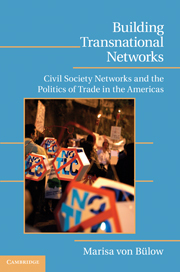Book contents
- Frontmatter
- Contents
- List of Figures
- List of Tables
- Acknowledgments
- Part One Civil Society Organizations and Their Pathways to Transnationality
- Part Two The Politicization of Trade
- Part Three The Dynamics of Networks
- 5 TRADE PROTEST NETWORKS
- 6 THE ORIGINS AND DYNAMICS OF TRADE CHALLENGERS' NETWORKS
- Part Four Organizational Pathways to Transnationality
- Part Five The Search for Ideational Pathways
- Main Abbreviations Used
- Appendix A Lists of Interviews
- Appendix B Social Network Questionnaire (United States)
- Bibliography
- Index
6 - THE ORIGINS AND DYNAMICS OF TRADE CHALLENGERS' NETWORKS
Published online by Cambridge University Press: 05 October 2010
- Frontmatter
- Contents
- List of Figures
- List of Tables
- Acknowledgments
- Part One Civil Society Organizations and Their Pathways to Transnationality
- Part Two The Politicization of Trade
- Part Three The Dynamics of Networks
- 5 TRADE PROTEST NETWORKS
- 6 THE ORIGINS AND DYNAMICS OF TRADE CHALLENGERS' NETWORKS
- Part Four Organizational Pathways to Transnationality
- Part Five The Search for Ideational Pathways
- Main Abbreviations Used
- Appendix A Lists of Interviews
- Appendix B Social Network Questionnaire (United States)
- Bibliography
- Index
Summary
How did a select number of labor, rural, and nongovernmental organizations (NGOs) come to form the core of the networks of trade challengers, within and beyond national boundaries? In order to answer this question, it is necessary to put the social network data presented in the last chapter in a historical context. The analysis presented below provides a detailed account of the origins of transnational ties within these three groups of organizations, and the pathways to transnationality taken by civil society organizations (CSOs) from each of these sectoral domains, as they responded to changes in their relational and political environments.
This approach makes sense if we consider that transnational ties have tended historically to be stronger among similar types of organizations, a trend that, according to the network data uncovered, seems to still hold true. At the same time, the data also showed some evidence for what the literature on transnationalism has been arguing: that cross-sectoral, multi-issue ties have become more common in the last few decades. An analysis that focuses on both intra- and intersectoral ties, such as the one presented below, shows that the construction of domestic and transnational networks among trade challengers has been full of tensions and ambiguities.
The Power of Labor Organizations and Its Limits
In total, informants from eight national labor federations and eighteen key sectoral unions answered the social network questionnaires in Brazil, Chile, Mexico, and the United States (see Appendix A).
- Type
- Chapter
- Information
- Building Transnational NetworksCivil Society and the Politics of Trade in the Americas, pp. 81 - 114Publisher: Cambridge University PressPrint publication year: 2010

